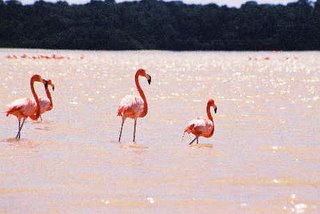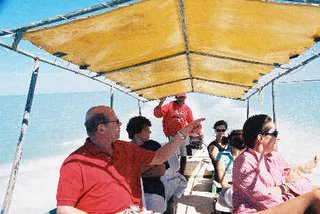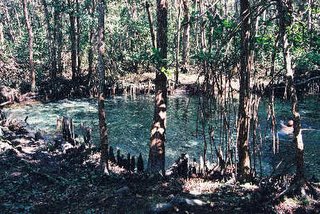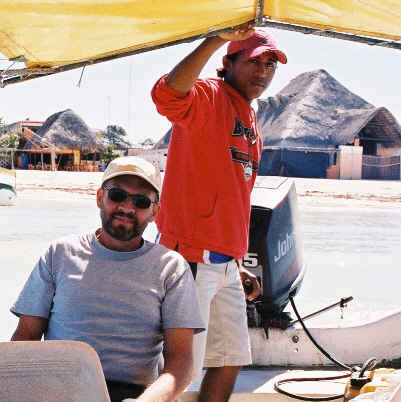 Every tourist guide I have consulted since beginning my Yucatan research, in preparation for my move here, recommends a trip to Celestun. The guides cite the boat excursions through the tidal estuary of the Ria Celestun Biosphere Reserve that afford views and photo opportunities of the vast flocks of flamingos; hundreds of other bird species; a swim in the clear, cool fresh water springs that bubble to the surface and drain into the estuary; a stop to view the “petrified forest” which, as I suspected, is not really petrified; and a ride through one of the sloughs that penetrate the dense mangrove forests that flank the estuary. The guides also encourage lunch in one of the town’s many seafood restaurants.
Every tourist guide I have consulted since beginning my Yucatan research, in preparation for my move here, recommends a trip to Celestun. The guides cite the boat excursions through the tidal estuary of the Ria Celestun Biosphere Reserve that afford views and photo opportunities of the vast flocks of flamingos; hundreds of other bird species; a swim in the clear, cool fresh water springs that bubble to the surface and drain into the estuary; a stop to view the “petrified forest” which, as I suspected, is not really petrified; and a ride through one of the sloughs that penetrate the dense mangrove forests that flank the estuary. The guides also encourage lunch in one of the town’s many seafood restaurants.The tourist guides are right. Celestun is well worth a visit. The exhilarating boat ride, bouncing through the Gulf waters to the Southern end of the peninsula upon which the town of Celestun resides and which separates the Gulf from the estuary, is itself worth the trip.
 Being a freelance tourist who avoids guided tours, I opted for a “servicio intermedio” (second class) bus to Celestun. The bus traveled through the towns of Hunucma, Kinchil, and a number of smaller communities which afforded views of traditional Mayan homes and other interesting local sites. The bus stopped frequently along the way, during the two hour trip, to take on and discharge passengers.
Being a freelance tourist who avoids guided tours, I opted for a “servicio intermedio” (second class) bus to Celestun. The bus traveled through the towns of Hunucma, Kinchil, and a number of smaller communities which afforded views of traditional Mayan homes and other interesting local sites. The bus stopped frequently along the way, during the two hour trip, to take on and discharge passengers.As I descended the bus steps upon our arrival in Celestun, I was immediately approached by a fellow who identified himself as Hector Marine, who, I discovered as he addressed the five tourists from the bus, speaks, at least, Spanish, English and Italian. Hector asked us each, an Italian couple, an Asian couple, and me, if we were there for a boat excursion. While Hector showed the Asian couple to their hotel I walked the one block to the beach to wait for Hector’s return.
Shortly, I joined a very ni
 ce French family of five in wading through the light surf to board a boat piloted by Pedro, our “muy amable” young barcodero who was entirely competent in identifying the various species of flora and fauna and explaining the sights. I discovered there are also tour boats which leave from the estuary side of the peninsula, but I understand they cost more, the tour is about an hour less in duration, and the trip does not include a high speed dash down the Gulf coast to access the estuary. Besides, in keeping with my freelance predilections, I’d rather deal with the independent Gulf side operators.
ce French family of five in wading through the light surf to board a boat piloted by Pedro, our “muy amable” young barcodero who was entirely competent in identifying the various species of flora and fauna and explaining the sights. I discovered there are also tour boats which leave from the estuary side of the peninsula, but I understand they cost more, the tour is about an hour less in duration, and the trip does not include a high speed dash down the Gulf coast to access the estuary. Besides, in keeping with my freelance predilections, I’d rather deal with the independent Gulf side operators. There are indeed large flocks of pink flamingos, which are pink due to their beta-carotene rich diet; lots of gray and white pelicans; cormorants everywhere; vultures circling overhead; egrets; and many other species of birds. The French family took a swim in the beautiful fresh water spring, which is essentially a cenote nestled in the mangrove forest and which drains into the estuary. Pedro piloted the boat, fairly rapidly, through a slough that weaves through the mangroves and in which during the night one may see crocodiles. And Pedro landed the boat for the short walk to the “petrified forest”, which is actually, what along the Washington coast of the USA is referred to as, a “ghost forest.” The land, according to Pedro, subsided 80 to 100 years ago during a seismic event, thus allowing the intrusion of seawater which killed the trees, the ghosts of which remain standing.
There are indeed large flocks of pink flamingos, which are pink due to their beta-carotene rich diet; lots of gray and white pelicans; cormorants everywhere; vultures circling overhead; egrets; and many other species of birds. The French family took a swim in the beautiful fresh water spring, which is essentially a cenote nestled in the mangrove forest and which drains into the estuary. Pedro piloted the boat, fairly rapidly, through a slough that weaves through the mangroves and in which during the night one may see crocodiles. And Pedro landed the boat for the short walk to the “petrified forest”, which is actually, what along the Washington coast of the USA is referred to as, a “ghost forest.” The land, according to Pedro, subsided 80 to 100 years ago during a seismic event, thus allowing the intrusion of seawater which killed the trees, the ghosts of which remain standing. After the boat excursion, I eschewed the tourist oriented, beach side restaurants and settled into the Nicte-Ha restaurant one block back from the beach. The beers were $6 pesos cheaper than at beach side; and, though I didn’t compare lunch prices, I suspect that my lunch of lightly fried fish filets, tomatoes and onions in vinegar, rice, and a stack of 15 corn tortillas was also less expensive. The other attractions lacking, I suspect, in the beach side restaurants are waiters who go about their duties holding a baby and the chatter of seven, or so, grandchildren of the proprietors sitting in a corner watching TV.
After the boat excursion, I eschewed the tourist oriented, beach side restaurants and settled into the Nicte-Ha restaurant one block back from the beach. The beers were $6 pesos cheaper than at beach side; and, though I didn’t compare lunch prices, I suspect that my lunch of lightly fried fish filets, tomatoes and onions in vinegar, rice, and a stack of 15 corn tortillas was also less expensive. The other attractions lacking, I suspect, in the beach side restaurants are waiters who go about their duties holding a baby and the chatter of seven, or so, grandchildren of the proprietors sitting in a corner watching TV.The entire trip, including el barcodero Pedro’s $50 peso tip was less than $40. U. S. It was another great day in the Yucatan.
I am writing a longer, more detailed travel report I will post when completed, but for now I wanted to get some pictures posted.

3 comments:
Thanks, from a new (if temporary) expat, for recounting your trip to Celestún-- I appreciate your efforts to stay non-commercial whenever possible, and you've provided enough practical info that I'm now re-inspired to check out Celestún on my own.
And kudos on your blog in general. I like the mix of travel log, political commentary, etc., esp. since I don't feel quite so free to go there with my blog. I'm now enjoying political commentary by linking to your blog from mine. :) Cheers, KAT
Welcome Kat,
Thanks for checking in and for you very kind comments. I have also linked to your wonderful blog and followed your lead in moving my links section to the top of the sidebar. I've just recently learned how to go into the "template" and move things around.
By the way, I liked your chili offering.
Enjoy Celestun. I found it much more interesting and the town much nicer than either Progreso or Chelem.
It's not easy for me to grasp the travel through Celestun having only been as far from Elma, WA as Devil's Canyon in Colorado, where I repelled off a 200 foot cliff for the first time, but your word and photography has allowed me to see gather the essence. Wonderful trip.
I agree with Katravel in that you side-bar commercialism. It's a digression of sorts that keeps it interesting an original.
Fine job of relaying your experiences to us.
Also, and I should let Kat know, that the way she describes frijol con puerco makes me want some in a bad way. Perhaps I will comment to her and simply ask to vacume pack and send to me, como se de se ASAP.. :)
Post a Comment